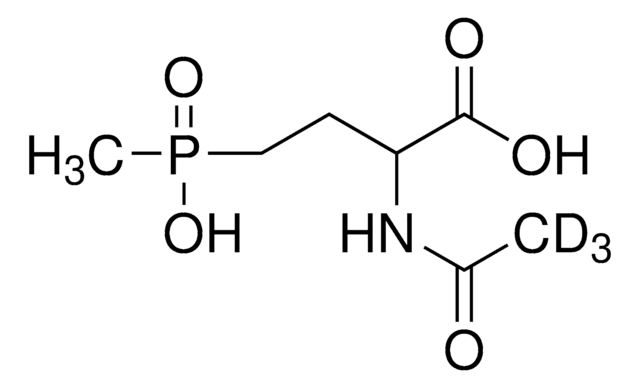05164
(Aminomethyl)phosphonic acid
PESTANAL®, analytical standard
Synonym(s):
AMPA
About This Item
Recommended Products
grade
analytical standard
Quality Level
product line
PESTANAL®
assay
≥98.0% (TLC)
shelf life
limited shelf life, expiry date on the label
impurities
≤3.0% water (calc. from elemental analysis)
application(s)
agriculture
environmental
format
neat
SMILES string
NCP(O)(O)=O
InChI
1S/CH6NO3P/c2-1-6(3,4)5/h1-2H2,(H2,3,4,5)
InChI key
MGRVRXRGTBOSHW-UHFFFAOYSA-N
Looking for similar products? Visit Product Comparison Guide
Related Categories
Recommended products
Legal Information
Storage Class
11 - Combustible Solids
wgk_germany
WGK 3
flash_point_f
Not applicable
flash_point_c
Not applicable
Choose from one of the most recent versions:
Already Own This Product?
Find documentation for the products that you have recently purchased in the Document Library.
Customers Also Viewed
Articles
A precise U/HPLC-MS/MS method with QuEChERS extraction for the analysis of glyphosate, glufosinate, and AMPA in green tea.
Glyphosate and related compounds are measured in oatmeal and infant cereal using ion-exchange polymer-based particles for HPLC and SPE. Low level detection was obtained.
Glyphosate analysis: LC-MS/MS method with Supel™ Carbon LC U/HPLC column for stability and retention.
Protocols
EPA Method 547 outlines the analysis of glyphosate in drinking water by direct aqueous injection HPLC, post column derivatization, and fluorescence detection
LC/MS Analysis of Glyphosate and Metabolites on apHera™ NH2, 2 mm I.D. Column
Our team of scientists has experience in all areas of research including Life Science, Material Science, Chemical Synthesis, Chromatography, Analytical and many others.
Contact Technical Service






